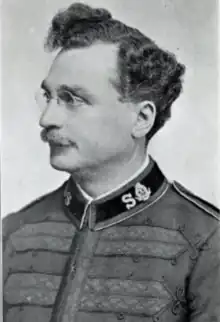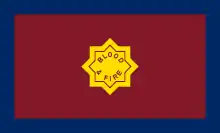Henry Mapp
Henry Mapp was a British minister and Salvation Army officer who served as the 4th Chief of the Staff of The Salvation Army.
Commissioner Henry Mapp | |
|---|---|
 | |
| 4th Chief of the Staff | |
| In office 5 March 1929 – 21 May 1937 | |
| General | Edward Higgins Evangeline Booth |
| Preceded by | Edward Higgins |
| Succeeded by | John McMillan |
| Personal details | |
| Born | British India |
| Died | April 2, 1955 |
| Nationality | British |
Career
Mapp was commissioned by the Salvation Army in 1888 and served in British India and Ceylon before being transferred to London. He held administrative positions in Great Britain, Canada, South America, and Japan.[1] General Bramwell Booth sent Mapp to Russia to establish a branch of the Salvation Army. However, communist revolutionaries forced the organisation to leave after the Bolshevik Revolution.[2]
In 1929, while serving the organisation's international secretary, he participated in the first High Council of The Salvation Army, which successfully voted to remove the seriously ill General Bramwell Booth from office.[3] Following Bramwell Booths removal from office, Mapp became Chief of the Staff of The Salvation Army under General Edward Higgins. Upon Higgins's retirement 1934, Mapp sought to succeed him as general.[4] However, Evangeline Booth was elected to the position by the High Council.[5] In 1937, Evangeline Booth removed Mapp as chief of staff after he became seriously ill and declared a leave of absence.[6] She also accused him of various secret charges of immoral character which were never officially made public.[1][7]
Mapp, however demanded, under Army rules, a hearing before a panel. The five-officer panel unanimously supported Booth's decision to remove Mapp as chief of staff and found him guilty of the secret charges.[7] Rumors spread that Mapp was involved in an extramarital affair, to which he announced he would sue for defamation of character.[8] Mapp claimed that he was dismissed as chief of staff because of his request to the general to retire on account of ill health.[9]
References
- "SALVATION ARMY OFFICER DISMISSED". nla.gov.au. National Library of Australia. Retrieved 12 June 2023.
- "SALVATION ARMY DRIVEN FROM RUSSIA INTO SWEDEN". The Rocky Mountain News. 60 (1). 1 January 1919. Retrieved 12 June 2023.
- Docter, Robert. "The Salvation Army's first High Council—Courage or Coup?". caringmagazine.org. The Salvation Army. Retrieved 12 June 2023.
- "A program for the Dedication and Commissioning of Cadets by Commissioner Henry W. Mapp, International Secretary, supported by Commissioner Adam Gifford., and Col. William S. Barker, May 26, 1926". pastperfectonline.com. Retrieved 12 June 2023.
- "Religion: Dynasty Restored". TIME. Retrieved 12 June 2023.
- "COMMISSIONER MAPP ILL; Salvation Army's Chief of Staff in Doctor's Care in London". nytimes.com. New York Times. Retrieved 12 June 2023.
- "GEN. BOOTH OUSTS HER CHIEF OF STAFF; Commissioner Mapp Is Found Guilty of Secret Charges by Salvation Army Court HE CONDEMNS TRIBUNAL Lawyers Serve Papers Indicatitig Legal Action in London for Defamation of Character Civil Court Action Seen". nytimes.com. New York Times. Retrieved 12 June 2023.
- "Religion: Mapp Out". TIME. Retrieved 12 June 2023.
- "SALVATION ARMY GENERAL AND CHIEF OF STAFF Dismissed Commissioner On Contents Of Letter". nla.gov.au. National Library of Australia. Retrieved 12 June 2023.
